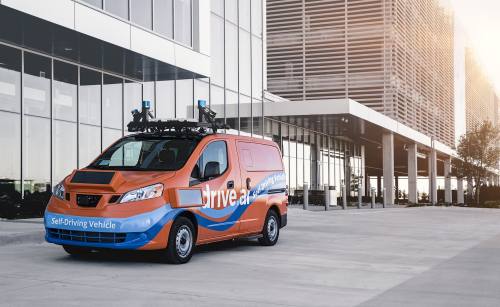- The program starts with fixed pickup and drop-off locations around Hall Park and The Star, with a planned expansion to Frisco Station.
- People can gain access to Drive.ai’s ride-hailing smartphone app to hail complimentary on-demand rides in the self-driving cars.
- The pilot program starts out with four bright orange Nissan NV200 vans that run in a tightly geofenced area—virtual geographic boundary—along fixed routes.
- The pilot program will be monitored in phases. It will start with a driver at the wheel monitoring how the vehicle is running, then eventually the driver will be removed, and a chaperone will be in the passenger seat assisting passengers and monitoring operations. The chaperone will eventually go away as well, and the car will continue to be monitored remotely.
- The vehicles have four LED screens that will communicate with pedestrians and other drivers about what the self-driving cars are doing. The screens will display messages such as "waiting for you to cross" and "passengers entering/exiting."
- Drive.ai has deployed telechoice technology to add another layer of safety. The technology helps the vehicle if it encounters a problem. Through telechoice the operator can control the car directly.
- The pilot program is a collaboration between Drive.ai and the Frisco Transportation Management Association—a public-private partnership between the city of Frisco, Denton County Transportation Authority, Hall Group, Frisco Station Partners and The Star in Frisco.
Select your community
Become an InCIder
News
- Austin Metro
-
Houston Metro
- Houston Metro Home
- Bay Area
- Bellaire | Meyerland | West University
- Conroe | Montgomery
- Cy-Fair | Jersey Village
- Cypress
- Heights | River Oaks | Montrose
- Katy | Fulshear
- Lake Houston | Humble | Kingwood
- New Caney | Porter
- Pearland | Friendswood | Manvel
- Spring | Klein
- Sugar Land | Missouri City
- The Woodlands
- Tomball | Magnolia
- Dallas | Fort Worth Metro
- San Antonio Metro





